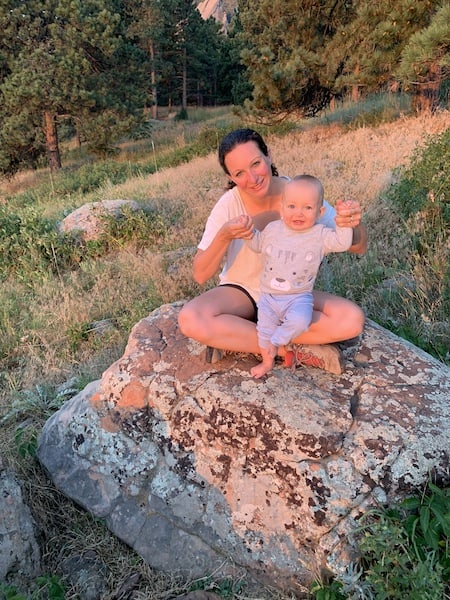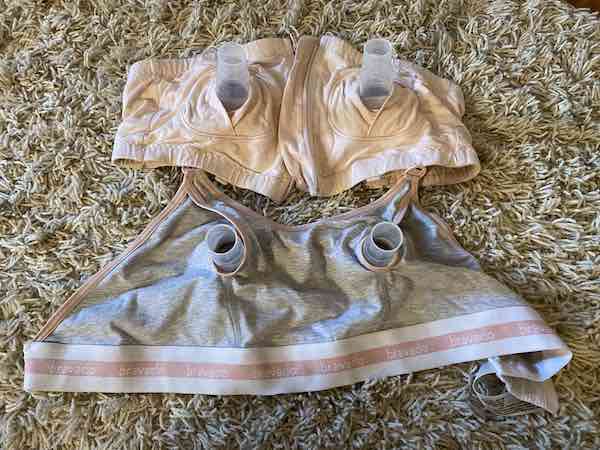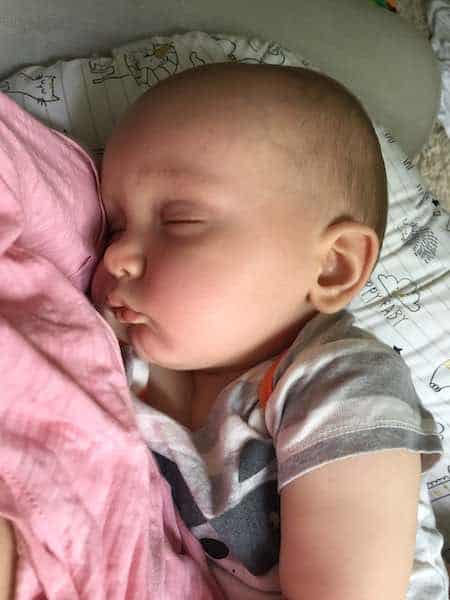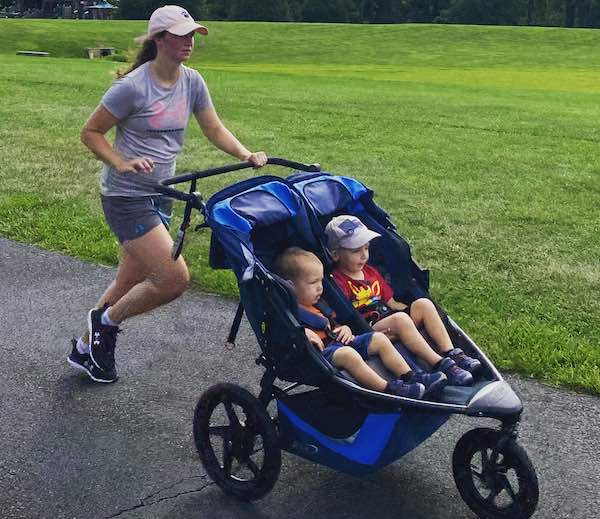My Pumping Schedule while Breastfeeding

Kristina
—Aug 05, 2021
Pumping mommas are superstars! The reality of life is that even if you are breastfeeding you might also have to pump. Whether it is to build up a supply for when you go back to work or want your baby to get use to a bottle so others can feed your baby pumping is required.

My first son was born in 2018 and I was a full time employee, (I did have Wednesdays off), as well as a full time MBA student. I also chose to exclusively breastfeed my child. Since I was away from my baby, more than I would have liked, I needed to pump to keep up my supply.
The frequency of pumping changed as my baby got older and was introduced to solid foods. Right around my son’s first birthday he decided he was done with breastfeeding and we had an abrupt stop, while I had to keep pumping to wean my body off.
My second son abruptly stopped at 10.5 months!
In this article:
- The Pumping Gear
- Pumping Schedule While Breastfeeding Facts and Figures
- 0-3 Month Old Baby
- 3-6 Month** Old Baby
- 6-12 Month Old Baby
- Useful Tips for Pumping Away From Home:
- Challenges with Breastfeeding and Pumping
- Hard Realities of Pumping
- Tips for Working Out and Pumping
- Common Questions on Pumping While Breastfeeding: My Experience
Disclosure: Some of the links below are affiliate links. This means that, at zero cost to you, I will earn an affiliate commission if you click through the link and finalize a purchase. Rest assured all products I suggest are products I have bought or would buy based on personal experience or through my network of other mommas.
The Pumping Gear
The Haaka
The Haaka is a great pump for early on in breastfeeding. If you are looking to build up your breastmilk supply the Haaka can help, especially at night time!
The Haaka is a silicone breast pump that works via suction while you are breastfeeding. You simply place it on the breast that your baby is not currently on and gently squeeze; when your baby triggers a let down the Haaka will start collecting the milk from your other breast. Normally this milk is lost, but with the Haaka you can capture it.
My second son favored one breast and in the middle of the night only wanted one breast before falling back to sleep. If I didn't collect the milk from the other breast I was uncomfortable, my breasts were lopsided. I would have had to use my electric pump to pump some milk out, but the Haaka saved me. The Haaka collected enough milk through let down and suction to allow me to feed only on one side and not feel engorged.
The Haaka won't give you tons of milk each feeding, but a small amount each time. I collected about 2ml each session and over time this accumulated to a healthy supply of breastmilk.
A BreastPump
A pump is essential if you plan on providing breastmilk for your baby, if you can’t always be with your baby. Most insurance companies will give you a free pump every time you have a baby, as long as they are two years apart (this was the case for my Blue Cross Blue Shield Massachusetts provider). Pumps are around $300+, so it’s great if you can get it for free.
You can enter your state and health care provider to view what your options are here.
Most insurance companies offer you a choice between Medela, Spectra, Lansinoh and some other small brands, I got the Medela Pump. I would recommend a double electric pump as these pumps are more efficient and result in more milk being pumped.
Each breastpump has their own network of parts and it is worth it to have many pairs. When you return to work your life might feel like it has become nothing but washing pumping gear, mine sure did. Eventually I invested in more parts so I could wash them in the dishwasher instead of hand washing them each night.
I recommend investing in extra parts early to save yourself time and frustration.
If it’s possible for you to leave spare parts at your place of employment or in your car do so! There will probably be a day when you forget your pumping parts and this will save you the hassle of either going back home or running out to the store.
I forgot flanges once at an all day weekend class and my director went out to Target for me, (the same director who helped me when my water broke at class).
Pumping Parts and Bottles
The flanges that you put over your nipples come in different sizes, make sure you spend the time to understand what size will fit your nipples. The wrong size flanges results in less milk output and a more painful pumping experience. Your nipple size may change during your pumping experience.
The three breastpumps I mentioned all come with their own bottle network. Once you are done pumping into these bottles there is a nipple design to fit the bottle. Although this is great, it does not guarantee your baby will take to that bottle nipple.
I breastfed my babies as much as possible and only introduced the bottle when daycare was starting. Much to my dismay, my boys preferred different bottle nipples than Medela and both different bottles from each other.
When I say preferred, what I really mean is they would only drink milk if it was in that specific bottle. If I tried any other bottle they would go on hunger strike for days!!
Pumping bras

Medela Zip Front (Top) vs Bravado hook in the back (Bottom)
Owning a couple pairs of pumping bras comes in handy. For my first child I used the Medela easy hands free pumping bra. The bra is strapless and zips between your boobs. I used this bra for over a year, however for my second child I found a better alternative that didn't require to take my bra off. I felt awkward completely undressing the top half of my body in my office pumping room.
After recommendations from my friends, I bought a BRAVADO hands free pumping accessory. This bra insert snaps onto your nursing bras. All you have to do is clip the BRAVADO to your nursing bra and you are ready to input your flanges. With this option I didn’t need to take off my shirt or bra. WIN!
Pumping Schedule While Breastfeeding Facts and Figures
Heathline reports the following eating schedules for a baby at different months
1 to 3 months: Your baby will feed 7 to 9 times per 24 hours.3 months: Feedings take place 6 to 8 times in 24 hours.6 months: Your baby will feed around 6 times a day.12 months: Nursing may drop to about 4 times a day. The introduction of solids at about 6 months helps to fuel your baby’s adHealthline Baby Feeding Schedule
If you are exclusively using breast milk, either by pumping or breastfeeding you will need to pump as often as your baby is eating. For example if your baby is eating every 2 hours during the day and you cannot be with your baby for one of those sessions you will have to pump.
How much milk your body produces is based off of supply and demand. The more you stimulate your breast by pumping/feeding the more your signal to your body that you need milk. If you pump less frequently than your baby eats your milk supply will drop.
0-3 Month Old Baby
My Pumping Schedule While Breastfeeding
First Baby Pumping Schedule: Had to Be away from baby for school
- Pumped 30 minutes after first breastfeed in the morning to build up supply
- Pumped for every miss feed when I wasn't with my baby
With my first baby I still had MBA classes to go to while on maternity leave. To build up a bigger supply I would pump 30 minutes after breastfeeding my baby in the morning. When in my 4 hour classes I would take a break 2 hours in and pump.
Pro Tip: Your milk supply is greater in the morning than in the evenings
Second Baby Schedule: No time away from baby
- Used my Haaka during nighttime feedings to build up supply
I was on maternity leave for the first 3 months of my babies life. I didn't have to be apart therefore I breastfed my baby and only used my haaka.
My Babies Feeding Schedules
Newborns eat every hour and a half to two hours after the start of the last feed and each feeding can take over half an hour. There are also times when your baby is cluster feeding and your baby will feed half an hour after you just fed them.
During the day both my babies ate every 2 hours. They both when through periods of cluster feeding where they would eat every hour. These times can be rough. I would suggest getting some good books to read and snuggling up in your nursing chair for these sessions.

Night time can be rough when you are getting up every two to four hours to feed your baby. My babies followed this pattern, as they got closer to three months the time between feedings was closer to the 4 hour mark.
If you know you want to provide breastmilk for your child and won't be able to breastfeed make sure you start to build a supply early on; milk can stay frozen for up to 6 months. I used Lansinoh storage bags to freeze my milk. It doesn't matter what brand of pump you have all storage bags are designed the same.
3-6 Month** Old Baby
My Pumping Schedule
- Every 3 hours at day time during times I was away from baby
- Occasionally would add a morning pump 30 minutes after breastfeeding baby
My Babies Feeding Schedule
At this stage my babies nursed every 2-3 hours during the day and every 4-6 hours during the night. When I was separated from my baby I tried to mimimic that schedule and have as many pumping sessions as I would have had nursing sessions. This can be challenging when you are at work.
Common Work Day Pumping and Breastfeeding Schedule
- 2 a.m. breastfeed baby
- 6 a.m. breastfeed baby
- 8:30 a.m. pump
- 11 a.m. pump
- 1:30 p.m pump
- 4:30 pump
- 6:30 p.m breastfeed baby
- 10:30 p.m. breastfeed baby
When I knew my work day was busy I would add in the morning pump 30 minutes after breastfeeding my child. This gave me some wiggle room in case I dropped a pump in the day and keep my supply up.

Build your pumping sessions into your work calendar. If you don't you might forget, I often did or others will book meetings that aren't convenient for me.
The female body is amazing, but breastmilk supply works off of demand. The more you mimic breastfeeding the more milk will be produced, if you start dropping pumping sessions your supply will drop!
I found it uncomfortable when I first returned to the office. People noticed I would leave my desk 3 times a day for 20 to 25 minute “breaks”. I often was asked what I was doing andI would say things like “Oh, I need a momma break, I have a baby at home,” hoping they would put two and two together. Most people didn't. I started getting more comfortable saying “I am a breastfeeding mother, I have to pump,” and that normally did the trick.
Lugging in that pumping gear day in and day out requires determination. Walking out of long meetings because you have to pump for your baby is hard and you worry about your career. DON’T!
After the fact I came to realize that people gave me a lot of respect for being a pumping mom at work. It didn’t hurt my career or my prospects at all.
6-12 Month Old Baby
My Pumping Schedule
- Every 3-4 hours during times I was away from my baby during day
My Babies Feeding Schedule
At this stage my babies nursed every 3-4 hours during the day and went from one wake up during nighttime to sleeping through the night.
Common Work Day Pumping and Breastfeeding Schedule
- 6 a.m. Breastfeed Baby
- 9 a.m. Pump
- 12 p.m. Pump
- 4 p.m. Pump
- 6:30 p.m. Breastfeed Baby
- 11 p.m. Breastfeed Baby
Your baby should be eating some solid foods now and their demand on milk is slowly going down. Feedings are more spread out and you are getting longer stretches of sleep at night! Life is pretty good. However, you still have to keep momentum up so your milk supply does not dwindle.
Useful Tips for Pumping Away From Home:
- You don't need to wash your equipment each time. Bring a plastic bag and after pumping, place your pumping gear into the ziplock bag and place in the refrigerator/cooler. As long as you are pumping every 4 hours or less you can reuse the parts in the bag. At the end of the day wash the parts or take home to wash in your dishwasher.
- Bring a couple of photos of your baby to place in your pumping space. This will help you visualize why you are putting in the effort and help put you in the right frame of mind.
- Try not to stress while pumping, stress can lower your output. If you are able, try to take a work break and let your mind relax.
- Have a separate cooler/bag to transport your breastmilk back and forth. This bag is going to go everywhere with you, keep it organized and clean!
- Don't be afraid to ask for what you need. You are providing your baby with their nutrition and you are a great mom!
Challenges with Breastfeeding and Pumping
Most mothers have a goal of how long they want to breastfeed; mine was always the one year mark. There is no right and wrong answer, but something you have to figure out with your baby and yourself.

With both of my boys they abruptly stopped breastfeeding. I begged them to nurse, as my body was not done producing breast milk, but nothing I did got them back to the breast.
If this happens before you are done continue to mimic your baby’s drinking habits with pumping. Your milk supply might start to decrease while exclusively pumping and you might have to find ways to increase it. Adding an additional pumping session if you notice your supply dropping would be a good start.
I had to slowly wean my body from producing breastmilk while exclusively pumping. I would drop one pumping session a week. Dropping too quickly, for me, caused clogged ducts and pain.
Everyone’s period returns at different times and some lucky people don’t get it back until after they are done nursing. However, if you are not one of those lucky ones it is good to know that during menstruation it is common for your milk supply to drop.
Some women do feel that their nipples are more sensitive at the time of ovulation, while others report a slightly lower milk supply on the days they have their period throughout the time they’re breastfeeding. They may also notice that their babies fuss a little more, as they aren’t getting as much milk as they’re used to.Todays Parent Article, Nathalie Pambrun, vice-president of the Canadian Association of Midwives
Stick it out and keep on track and your supply should return. It can also be different for different babies. My period returned at 8 months postpartum after my first son and not untill over 12 months postpartum with my second.
If you start supplementing your milk supply with formula your supply will further drop. This is a strategy some mommas take when they feel it is right for them to stop breastfeeding. You cannot stop breastfeeding cold turkey, you will be INCREDIBLY uncomfortable and more likely to get Mastitis and Clogged Ducts.
Hard Realities of Pumping
No matter how great your pump is, pumping is more painful than breastfeeding. When I was in the office for several days and pumping constantly my nipples were sore. When I started my pump my nipples were sensitive for the first several seconds; there were many times that I questioned if I could continue.
However, when I went home and breastfeed my baby after a long day of work I knew that for me it was worth it. (Also note, if pumping is particularly painful your flange size might be wrong, make sure you check!)
Pumping is not as efficient as breastfeeding. Pumping is great, as it allows us breastfeeding mommas to be away from our babies without feeling guilty that we are not providing for them, but it’s not the same.
Tips for Working Out and Pumping
Get use to planning your workouts around pumping. For all you active mommas, it is painful to run while your boobs are full. It is best to exercise immediately after pumping or nursing, if not, you are more likely to get a clogged duct and be uncomfortable.

If you hike with your baby plan the start of the hike right after pumping or feeding your baby.
I was part of a running group at work and I had to reserve the nursing room immediately before the run group started. There were weeks where I couldn’t pump beforehand and I canceled my run. Clogged ducts are not fun and can take a couple of days to sort out.
If your goal is to provide breastmilk for your baby and you're not able to be with your baby 24/7 pumping is an answer. It is going to be hard and you might question why you continue to pump, especially when you're lugging around your pumping bag and cooler everyday, but, know you are awesome and that dedication is amazing! Keep it up!
Common Questions on Pumping While Breastfeeding: My Experience
How many times should I pump while breastfeeding?
Depends on your situations and your breastfeeding goals. I wanted to exclusively breastfeed and for my first son wanted to build up a supply before returning to work. I only had to pump once a day to achieve this. For my second son the Haaka was enough to build up a supply before returning to work.
If I felt my supply was dropping I would add in pumping session 30 minutes after feeding baby. This would help to increase my supply in the coming days.
Is it OK to pump once a day while breastfeeding?
Of course. This is the method I used to build up a large supply for when I went back to work. I found the best time to add a pump session in is 30 minutes after my first nursing session in the morning.
How do you alternate between pumping and breastfeeding?
If I was not home to nurse my baby and it was my baby's feeding time I would pump. I used an electric double pump to pump both breast at the same time. I found pumping for 20 minutes was sufficient for me to obtain 4-5 oz of breastmilk. If I was home I would nurse and would always try for my baby to eat from both breasts. If not I would use my Haaka.
KellyMom is a great resource for breastfeeding, including pumping. The owner is an International Board Certified Lactation Consultant and mom of three.
Hope this information helps.




